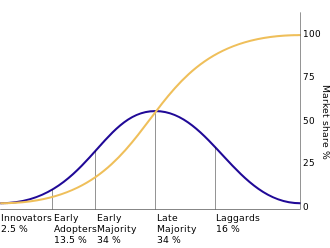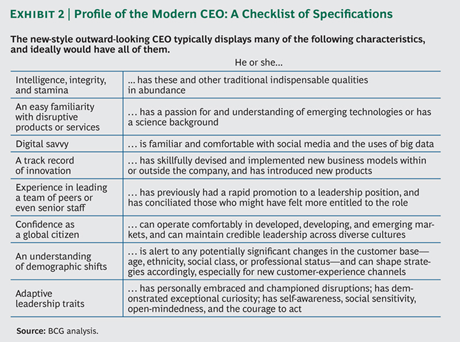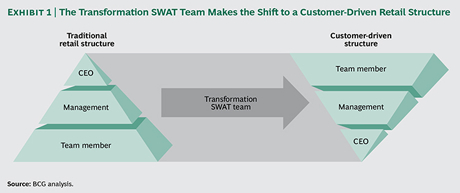In Diffusion Of Innovations (1962) sociologist and innovation theorist Everett Rogers explored how new ideas and technologies are spread. His work, re-published many times since, established some of the building blocks of the language of innovation we still use today. If you are familiar with the phrase “early adopters” , for example, you are using a concept coined by Rogers over 50 years ago.

Rogers was also an innovator of sorts in his methodology. In trying to solve the puzzle of how some innovative technologies became successful, while others failed, he used a multi-disciplinary perspective that incorporated insights from sciences, social sciences and the arts — at a time when these disciplines existed largely in academic siloes– to identify the drivers of successful innovations in achieving “critical mass” (another Rogers expression, borrowed from nuclear physics) of widespread user adoption.
Rogers brought a diverse body of research and insights into focus – exploring the importance of the technical characteristics of the innovation itself, communication channels, time, and social systems in getting to widespread adoption of new inventions. His perspective was also humanistic – placing people at the center of the process.
The Quixotic Quest For The Innovation Algorithm
In recent years, preoccupation among scientists and social scientists with “innovation” has reached a feverish pitch, spanning all institutions around the globe. Governments, universities, businesses (large and small), venture capitalists and other capital markets participants, research institutes, think tanks and thought leaders; all are obsessed with innovation. It can plausibly be argued that for many G20 countries, struggling with today’s growth and wealth creation challenges, innovation IS the new arms race.
At Organimi, we call this search the quest for the “innovation algorithm”.
We’re a small part of this process too. Organimi now has close to 200,000 members in our community, with 7,000 organizations that have created and shared over 10,000 org charts. We had a client share a great success story last week. It was nice to hear the feedback. We would love to hear your stories too!
Organimi users span businesses, both large and small, as well as public schools, high schools, colleges, universities, churches, synagogues, mosques, and countless not for profit organizations. Very traditional and well established companies use Organimi. We also have org charts for virtual teams, virtual organizations and fast growing start-ups.
We hope we’re delivering value to our users. But, as a cursory glance at the data from the Startup Genome project will show, the business of innovation these days is a frothy place. Organimi is one of literally hundreds of thousands of start-ups around the globe splattered around incubators, accelerators, labs, basements and coffee shops, mucking around in the primoridal soup of commercializing new ideas and trying to get investors to invest in them and early adopters to use them.
Obsessing about detecting, analyzing and optimizing the drivers of successful innovation — or growth hacking as it is fashionably (and therefore likely soon to be out of fashion) known — is all the rage in today’s start-up community.

Got The Big Blues? Change The Change Agents
But concerns about growth and innovation challenges are equally prevalent at the other end of the spectrum – much more than a marketing exercise, they are a pressing dilemma for the world’s largest companies.
IBM is a classic case of a large, global, tech saavy, traditionally successful business seeking to reinvent its own business against the backdrop of relentless innovation.
IBM’s recent earnings results and catastrophic earnings miss show the impact on its own business of fast paced change in cloud based technologies, information networks and commodity web services being delivered globally, in real time, with high availability, and comparable to better security, at low cost. Things seem more than a bit “blue” at Big Blue.
These realities are contrasted with a formerly unassailable “you don’t get fired for picking IBM” mainframe business and cultural model which is increasingly seen to be rooted in high cost, inflexible systems and rigid organizational hierarchies and processes.
And the competitors for IBM aren’t primarily startups nipping at its heels but giants like Amazon, Microsoft and Google all of whom have developed global scale and reach in deploying and delivering the same computing and telecommunications infrastructure that used to be the preserve of industry giants like IBM and AT&T; companies that continue to press their advantage by acquiring literally hundreds of early stage companies for their innovative technologies and people each year.
So what is IBM’s advice to its large enterprise clients on how they can address this business transformation and these innovation imperatives? It starts, as all IBM pitches do, at the top, seeking to grab the attention of CEOs who must “personally orchestrate innovation, establishing conditions that ignite ideas and drive their execution”.
Managing transformation, creating a vision of collaboration, major process changes, innovating technologies, implementing structures and networks, and establishing a participatory culture… these are all services that support your business in successfully achieving and sustaining major organizational change.
As recent work from the Boston Consulting Group confirms, some corporate boards – equally obsessed with innovation – are nowadays opting for “change the manager” over “change management”.
In their thoughtful piece on Leapfrog Succession BCG managing partner Roselind Torres and her team comment on an emerging trend among Fortune 500 boards to go deeper in their ranks to hire the next generation of CEOs in the “hope that the new CEOs’ ability to understand and act upon signals in today’s unpredictable environment will more than offset their relative inexperience.”

Fountain Of Youth Or Another Emperor Who Has No Clothes?
This notion that “the young” might be more adept at deciphering the innovation algorithm seems a bit of a stretch. Not because younger employees do not have great perspective and abilities in harnessing the capabilities of new technologies and reimagining their day to day work processes, but because of the organizational and cultural constraints on their abilities to actually execute on these ideas.
It is difficult to know what to make of this perspective on the relationship between “leader” and “innovation success”. BCG itself notes “we are in the early days of studying this phenomenon—and determining whether it represents a coincidence, fad, or trend.”
Other recent HBR research on the role and career path of women in senior executive positions describes a different process, and a much longer gestation period, for women getting to senior roles. And they seem to be performing quite nicely thank you very much!
So there is likely a reasonable degree of skepticism about the role of “the leader” in driving the innovation agenda – especially in larger organizations.
In a thought provoking article prepared for this year’s Drucker Forum (the annual conference named for Peter Drucker one of the world’s leading thinkers on modern business management), Gary Hamel goes even deeper writing in HBR that large organizations are “congenitally incapable of innovation or other profound change”.
His reasoning:
Hamel concludes that as the “creative destruction” we currently are experiencing continues to strengthen, these infirmities of large organizations will become even more debilitating. His conclusion? Organizations remain “still feudal at their core, with a raft of institutionalized distinctions between thinkers and doers—between the executive class and everyone else. And most leaders still over-value alignment and conformance and under-value heterodoxy and heresy. Until this changes, our organizations will be substantially less capable than they might be.”
Getting Organized For Growth: The Human League
Our take at Organimi is that the quest for the “innovation algorithm” is likely one of those very long marathons; a quest quite possibly even holy grail like in its need for a unique combination of time, place, luck, faith and random happenstance.
We’re skeptical that it can be based even in part on any sort of “great man” or great women theory, or a young leader theory, for that matter.
We do think that organizational structure matters. Organizational design matters. Experimentation matters.
In a recent blog, discussing the retailing industry, we talked about how leading retailers are inverting their stale organizational pyramids to have “swat teams” of client facing personnel bring innovations into the organization from the supplier-employee-customer ecosystem they exist in.

In another recent study on point, BCG focuses on how organizations – of all sizes – can align themselves better for growth.
Basing their own approach on the insight that most organizational growth initiatives fail “because of people and organizational shortcomings” they conclude at successful growth initiatives revolve around five organizational and people practices.
We’ve summarized these below and outlined how we think Organimi can help empower the innovation enablers in your organization:
Visible Active and Engaged Leadership
Growth often challenges an organization’s existing business models and resource allocation. Unless senior leaders visibly and actively support a growth initiative, the inertial forces of larger legacy businesses can smother it….Once a growth strategy has been set, one of the primary jobs of the CEO is to ensure that the entire senior leadership team supports the initiative and is committed to its long-term success. This is difficult work.
Using Organimi it is easy to create and empower a senior leadership team responsible for your innovation agenda, and broadcast that across the organization.
Creation of Cross-Functional Teams Leveraging All Needed Capabilities and Skills
To generate growth, companies will almost always need new organizational capabilities and individual skills. They may need technical or functional skills, such as digital or big-data capabilities. But they may also require new types of leaders…Finally, growth agendas almost always require cross-functional collaboration and fundamentally different ways of working. While cost cutting can frequently be achieved within functions and without new capabilities, that is almost never true of growth.
Using Organimi it is easier to identify and integrate the diversity of skillsets and capabilities across your team into a new organizational design created around innovation, bringing your people assets together on paper in various combinations as you look to experiment with an adaptive innovation approach to your organizational design.
Creating Cross-Functional Teams and Employee Connections
When the growth initiative is either distinct from or disruptive to the established core, separation makes sense. This unit can then attack the opportunity with its own talent, incentives, and cadence. When the growth initiative is adjacent—and either supportive or nonthreatening—to the core, it likely belongs within the core business organization and operating model.
Regardless of where the new growth initiative is housed, all companies will need to ensure that they have processes to promote cooperation across existing business and functional units. Forums, councils, and cross-functional teams are effective mechanisms for fostering this collaboration. In meetings of these groups, all parts of the organization come together to discuss progress, reset expectations, and make course corrections.
Whether your teams are separated or together under the same umbrella, you can organize and share easily who is on the innovation team, and clarify their roles and responsibilities, so that everyone can see where they fit at a glance.
Targeting Cultural Change
As part of a growth initiative, companies can develop processes that define and align performance, compensation, promotions, and penalties to ensure that they achieve their target culture, which will make it easier to achieve their business objectives.
If your organizational culture for innovation is based on access, transparency and shared responsibility, Organimi is a useful tool to reinforce these values.
Creating Deep Feedback Loops Within The Organization
Leaders need to transmit a consistent message to employees layer by layer throughout the organization, and receive and listen to feedback from deep within the organization, where the fate of change resides, in order to track progress and make adjustments.
Organimi makes real feedback possible – because it makes it possible for people to have meaningful personal connections based on shared understandings of their roles, contributions, skills and capabilities. Deep feedback depends on dialogue. Organimi helps make more meaningful dialogue possible across the team.
Organize Your Innovation Dream Team..with Organimi Org Charts
In another recent article on innovation and growth, Rolf-Christian Wentz suggests that “innovation machines” like Toyota, Procter & Gamble, GE, 3M, IBM, Google, Microsoft, Sony, Hewlett-Packard, DuPont, Honeywell and Whirlpool have already successfully adopted innovative organizational structures that deliver innovation faster to the business.
His observations, summarized below, reinforce the value and benefits of transparent organizational collaboration and experimentation in organizational design. They include the following principles:
1. Delegation of Decisions to Innovation Teams
2. Integration of R&D into the Business Units
3. Co-Location of Teams and Departments
4. Establishing Central Innovation Teams
5. Ensuring Central Innovation Funds
6. Creating An External Interface for Open Innovation
7. Aligning Merger & Acquisition Activities & Business Integration with the Innovation Agenda
So, if it is the case that innovation is on everyone’s agenda these days, it likely makes sense to stop waiting for the “great leader” to climb aboard the bus, and drive your organization off a change management cliff.
Instead, maybe it is time to start pulling together and sharing with other people on your staff some of your innovative organizational designs that bring your people together and let your dream teams get to work.

If you want to spend some time experimenting with new ways to build out your innovation team, there is no better tool than Organimi. Cloud based, private, and secure. And you can share your org charts with other people on the team. All free, for up to 500 members.
At Organimi, we are convinced that virtually every organization has the capability for innovation and growth – it is all about how they identify and harness the energy of the innovators on their teams.
We hope that once you start defining your organizational design with Organimi, and see the possibilities in front of you, this will become apparent, pretty quickly.
Creating an innovators org chart for your organization as an early adopter of Organimi is a good place for you to start.
As always, thanks for checking in.
The Organimi Team
